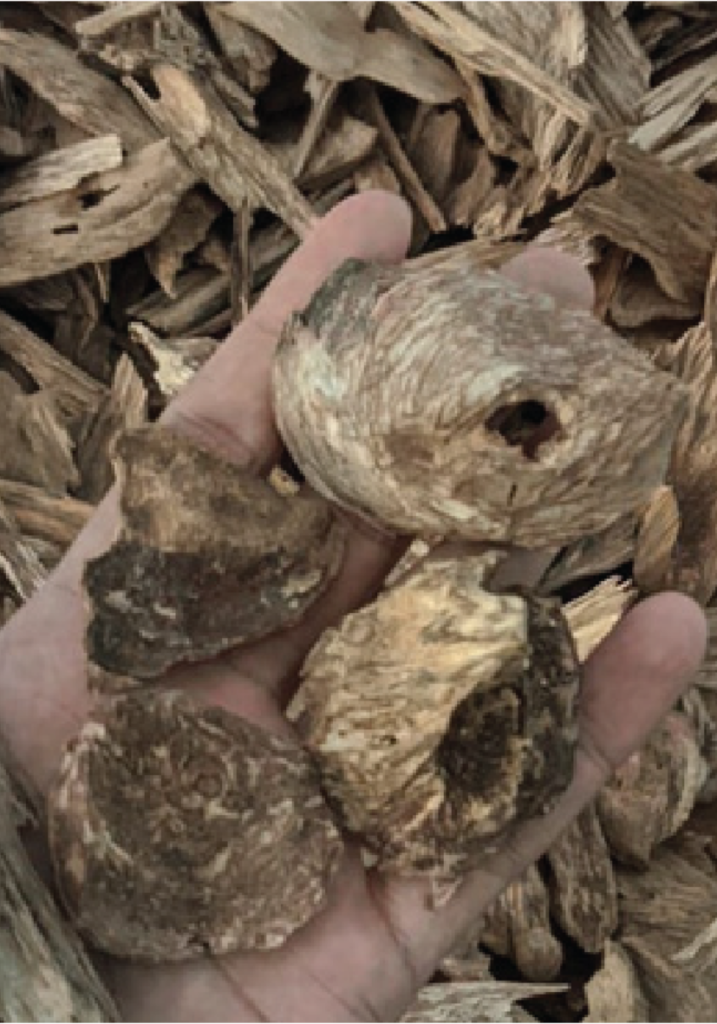Agarwood

Agarwood
Gaharu, also known as agarwood or oud, is a resinous wood that is highly valued for its distinctive fragrance. It is produced by several species of trees in the Aquilaria genus, which is native to Southeast Asia including Indonesia, India, and Bangladesh.
The formation of agarwood occurs when a particular type of
mold or fungus infects the trees. The tree responds to the
infection by producing a resinous substance that accumulates in the heartwood, eventually forming a dark, fragrant resinous material known as gaharu.
Gaharu has a rich, complex aroma that is highly prized in many cultures around the world. It is used in a variety of products, including perfumes, incense, and traditional medicines. Because
of its rarity and high demand, gaharu is also a valuable commodity, and it is often sold for very high prices.
Agarwood Producen
Indonesia is renowned for its production of Agarwood and is considered to be one of the leading producers in the world. The island of Kalimantan, specifically North Kalimantan, is particularly renowned for its high-quality Agarwood. The Agarwood found in North Kalimantan is noted for its aromatic resin, commonly referred to as gaharu sap, which is characterized by its thick consistency, deep black color, and intense aroma, surpassing the quality of other regions.
Gaharu Buaya and Gaharu Beringin are two types of gaharu
that are produced by specific species of trees.
Gaharu Buaya
This type of gaharu is produced by the Aquilaria beccariana
tree, which is also known as the “crocodile agarwood” because
of its distinctive crocodile-like bark. Gaharu Buaya has a rich,
earthy fragrance, and is highly valued in the perfume industry.
Gaharu Beringin
This type of gaharu is produced by the Ficus benjamina tree,
which is also known as the “weeping fig.” Gaharu Beringin has
a sweet, fruity fragrance, and is often used in traditional
medicines and perfumes.
Advantages of Agarwood
High Density and Durability
Agarwood is known for its heavy weight and hard texture, making it ideal for various uses.
Distinctive Grain Pattern
The unique wood grain of Agarwood adds character and beauty to any item it is used in.
Weather
Resistance
Agarwood is known to be resistant to various weather conditions, making it a suitable
choice for outdoor applications.
Long Lasting Fragrance
Agarwood is also prized for its typical, distinct scent, which is often sought after in
perfumes and other fragrances.
Benefits of Agarwood
As High-Quality Furniture
The heavyweight of Agarwood makes it sturdy and long lasting, making it a superior choice for furniture compared to teak wood. Although it is more expensive than other woods, it is worth the investment due to its durability.
As a Fragrance
The resin in the Agarwood tree can also be used as a fragrance ingredient in perfumes and scents. The resin is processed to extract its pleasant aroma.

For Health Benefits
Agarwood products are believed to have various health benefits, including:
- Agarwood Coffee, made from the extract of the Agarwood leaves, is said to improve sexual dysfunction, brain function, stamina, thyroid function, and sleep disturbances.
- Agarwood Tea, made from the leaves of Agarwood, is believed to help treat diabetes, asthma, prostate, cancer, kidney problems, and gout.
- Agarwood Essential Oil. The Agarwood tree contains
hirudin, which is believed to promote blood
circulation in the human body.


Here are some of the most common uses of gaharu
- Perfumery
- Incense
- Traditional medicine
- Wood carvings and decorative items
- Spiritual and cultural practices
Here are some of the most common forms of gaharu that are sold
- Wood chips
- Essential oils
- Incense sticks
- Carvings and decorative items
- Powder
We Export to
More Than
50 Countries
Worldwide

North America
Central America
South America
Oceania
Asia
Africa
Europe
